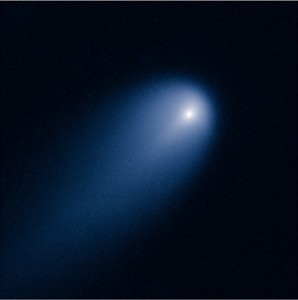by Ben Sheffler

Photo courtesy of NASA, taken by the Hubble Telescope
Dr. Clay Sherrod of Arkansas Sky Observatories gave a lecture at Pensacola State College to educate people on the approaching Comet ISON, as well as the history and science of comets, on Saturday, Oct. 12, highlighting a few days that the comet could best be viewed.
Comet ISON, an acronym for the International Scientific Optical Network, is making its first trip around the Sun, allowing it to be visible by the naked eye from late November through December.
Sherrod is optimistic about Comet ISON’s viewing opportunities, saying that “it’s going to be a very nice Christmas comet.”
On Christmas Eve, Comet ISON should be visible in the western sky, but until Nov. 29 it will be seen by looking due east. The time of day ISON is visible also changes on Nov. 29, switching from a pre-dawn to a sunset viewing.
Sherrod highlighted the early morning of Nov. 22, facing due east, as a potentially prime viewing opportunity.
PSC Astronomy Professor Dr. Wayne Wooten is predicting the comet can be seen by the naked eye starting between Nov. 10 and 15.
“It will be a good comet, comparable to Hale-Bopp,” Wooten said.

Photo courtesy of Bill Martinec, member of EAAA
PSC student Alex Sharp, whose major is pre-engineering, hasn’t ever seen a comet but said he’s “really looking forward to seeing one.”
Sherrod brought breaking news about the comet with him on Saturday, saying that Comet ISON hasn’t been spinning, which means that only one side has been exposed to the Sun. He said that ISON is beginning to spin, however, which is significant because the “mini volcanic eruptions” of gases that could take place from Sun exposure would result in a bigger and better ion tail—the part of a comet that’s most recognizable.
Comets are distinguished by a nucleus, coma and tail.
Comet ISON’s nucleus, the physical makeup of a comet, is three miles wide. In comparison, the nucleus of Halley’s Comet is six miles wide.
The coma, or head, of a comet is the glowing area around the nucleus. According to NASA, Comet ISON’s coma was 3,100 thousand miles wide when the Hubble Telescope photographed it in April. Halley’s Comet has a coma 1 million miles wide according to Sherrod.
“It looks like a ghost,” Sherrod said.
There are two types of comet tails—an ion and dust tail. The ion tail is made up of glowing gases and will always point in the opposite direction of the Sun because of solar wind, so it can actually be in front of the comet’s path. The dust tail is caused from the comet breaking apart, and it will follow the comet’s path.
“These things are spectacular,” Sherrod said. “Every comet is different.”
Sherrod is expecting Comet ISON to have both tails.
As of Saturday, Comet ISON was near the orbit of Mars traveling at 80,000 mph and the Sun’s atmosphere was beginning to reach and affect the comet. By Nov. 29, ISON will be traveling at 870,000 mph, making it one of the fastest moving comets ever, according to Sherrod.
Comets originate from deep space within the Oort Cloud, which extends beyond the hydrogen wall of our solar system, and Sherrod said Comet ISON has possibly taken 25 million years to get to Earth.
Sherrod also said that “all comets are possibly the same age,” formed 4.5 to 5 billion years ago.
Comet ISON was first discovered by Vitali Nevski and Artyom Novichonok on Sept. 21, 2012, as it was traveling around Uranus, where it had a short tail but was “quite bright,” according to Sherrod.
Unlike meteors, which are broken pieces of comets and streak across the sky, comets linger and hover in the sky.
Although all comets will disintegrate, trillions of comets exist, making them the most common thing in space, according to Sherrod.
Sherrod’s lecture was sponsored by the PSC student chapter of the Escambia Amateur Astronomers’ Association.
Sherrod, who saw his first comet in 1966, has 40 years of experience as an astronomer, researcher, author and lecturer, and although he’s optimistic about Comet ISON, he said, “We don’t really know what to expect.”
The EAAA hosts several events throughout the year, to which the public is welcome, at Fort Pickens and the Gulfside Pavilion, and their next meeting is Friday, Oct. 25, at 7 p.m. in room 1775 at PSC. The EAAA’s yearly student fee is $12, but students can join for the remainder of this year for just $3. For more information, visit their website at http://eaaa.net or contact Dr. Wooten at 850-484-1152 or wwooten@pensacolastate.edu.
Follow Ben Sheffler on Twitter @CorsairSheffler or https://twitter.com/corsairsheffler

